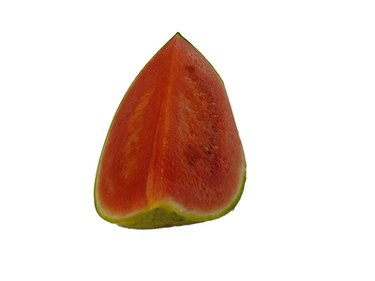
Moon and stars is a popular watermelon variety grown by commercial farmers and backyard gardeners. Once thought to be extinct, moon and stars seeds are available for planting from seed exchange companies. Like most watermelon varieties, moon and stars is relatively easy to cultivate. Perhaps the most difficult part of growing these watermelons is having the patience to wait until they are fully ripe before picking them.
Background
Video of the Day
Moon and star watermelons are heirloom melons, which means they are old cultivars whose seeds have been passed down from generation to generation. Originally called the sun, moon and stars watermelon, its seeds were first sold in the U.S. by Peter Henderson and Company in 1926, according to The Food Channel. Soon after being introduced to commercial and backyard growers, however, the watermelons seemingly became nonexistent. But in the 1980s, it became known that a farmer in Missouri still had been growing the melon.
Video of the Day
Appearance
Moon and star watermelons have a dark green exterior with bright yellow spots that nearly cover the rind. Most of the spots are small in size, although the melons usually have at least one much larger spot. The smaller spots are said to be the stars and the larger spot is the moon, hence its name. The seeded melon is slightly sweet, and has juicy, red flesh.
Cultivation
Moon and star watermelons require a long, hot growing season of about 80 days, in a soil temperature of 70 degrees Fahrenheit or hotter. Allow at least 4 feet of space between plants to accommodate vine growth, which can extend up to 20 feet. You generally do not need to worry about watering them unless you experience a period of drought. Limiting access to moisture helps make watermelon sweet, states website gardening resource Burpee Gardening. As vines begin to stray, apply 1/2 cup of a 5-10-5 fertilizer blend of nitrogen, phosphorous and potassium, which is enough fertilizer for about three watermelon plants.
Harvest
Once the watermelon tendril -- the slender coil nearest to the stem -- is brown and dry, turn the melon over and check the spot underneath where it sits on the ground. A mature moon and star melon that is ready for picking has a large, very yellow spot where it was laying on the ground. If the spot is white or pale yellow, do not pick it, as it's not quite ripe. Another way to determine whether a moon and star melon is ripe is to examine its rind, which will have lost its glossy color and become dull, states Burpee Gardening.